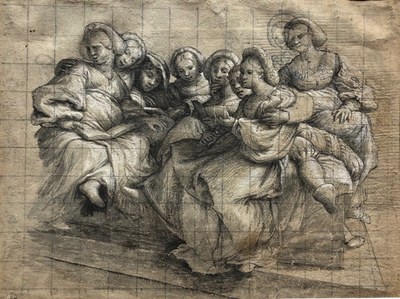Online-Workshop // Genevieve K. Verdigel: Drawing in Venice and the Veneto circa 1500–40: Media, Techniques and Functions
Dr. Genevieve K. Verdigel is the winner of the Wolfgang Ratjen Award 2021.
Drawing was a fundamental part of the working practices of artists active in Venice and the Veneto across the Renaissance period. Not only did artists deploy graphic techniques in various ways within their production of paintings and frescoes, but they also sought novel and innovative drawings methods in their use of media and technique. This is exemplified by the uptake of diverse coloured media such as blue paper and red chalk, and the retention of drawings within artisanal workshops for future reference. This workshop will consider the plurality of Venetian concepts of disegno in two ways. In the first half, it will focus on the use of a single medium - namely red chalk; while in the second, it will consider the graphic corpus of Lorenzo Lotto.  Red chalk has not been historically associated with Venetian drawing practice. It has long been assumed that it was Leonardo da Vinci who introduced the medium to the Lagoon in 1500, and thus that any usage of it was dependent on his example. There is, however, evidence to prove that artists active across the Veneto were using it during the fifteenth-century with extant examples by Pisanello, Vittore Carpaccio and Gentile Bellini. Drawings in red chalk by Titian, his workshop and Giorgione further reflect the absorption of the medium into Venetian graphic practices, while its usage by artists including Pordenone and Lorenzo Lotto invite further questions as to what role mobility played in innovations in the use of red chalk. In turn, the application of red chalk to square drawings for transfer (by Lotto, Titian and Pordenone) and to sketch out initial designs points to an awareness of the functional potential of the medium. These factors will be considered in order to change long upheld perspectives on red chalk and Venice.
Red chalk has not been historically associated with Venetian drawing practice. It has long been assumed that it was Leonardo da Vinci who introduced the medium to the Lagoon in 1500, and thus that any usage of it was dependent on his example. There is, however, evidence to prove that artists active across the Veneto were using it during the fifteenth-century with extant examples by Pisanello, Vittore Carpaccio and Gentile Bellini. Drawings in red chalk by Titian, his workshop and Giorgione further reflect the absorption of the medium into Venetian graphic practices, while its usage by artists including Pordenone and Lorenzo Lotto invite further questions as to what role mobility played in innovations in the use of red chalk. In turn, the application of red chalk to square drawings for transfer (by Lotto, Titian and Pordenone) and to sketch out initial designs points to an awareness of the functional potential of the medium. These factors will be considered in order to change long upheld perspectives on red chalk and Venice.
The graphic corpus of Lorenzo Lotto remains a muddied water, with optimistic counts placing the number of extant drawings at around 40, and more cautious placing the figure at 20. In-between this disparity, there is much variety in the technique, style and function of these drawings. Several can be identified as initial compositional sketches, others as facial studies, some as finished modelli, and one as an intarsia design. That the catalogue of Lotto drawings has not yet been completed, despite recent developments in scholarship in his paintings (including Enrico dal Pozzolo’s forthcoming catalogue raisonné) allows for a situation in which analysis of attributions can be made through various approaches. These include study of the media, the style, the purpose, the reuse, the motifs and documentary references. By taking all such elements into account, and discussing their merits and limitations, a case will be made for a reasoned, and careful, construction of the catalogue raisonné of Lorenzo Lotto’s drawings.
[Caption: Lorenzo Lotto, Six Women and Two Youths singing, pen and ink with wash and white heightening over black chalk, 249 x 324 mm (Florence, Gallerie degli Uffizi)]
____________
Diese Veranstaltung findet als internes Zoom-Meeting statt / This event takes place as an internal Zoom meeting.
